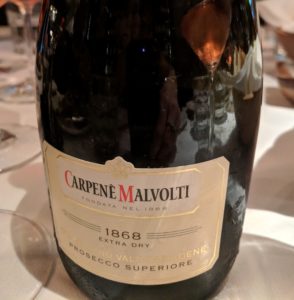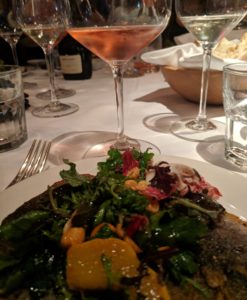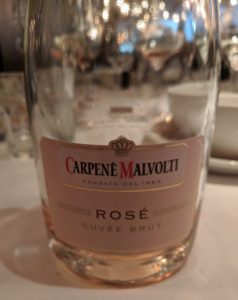 I have always held the personal belief that everything is better that sparkles – water, wine, personalities and diamonds! And, lately, the world seems to agree with me. While consumption of red and white still wine remains flat (pun intended), the consumption of sparkling wine has risen dramatically since 2009 and is expected to grow annually by nearly 6% from 2018-2021, indicating significant increased interest in bubbles.*
I have always held the personal belief that everything is better that sparkles – water, wine, personalities and diamonds! And, lately, the world seems to agree with me. While consumption of red and white still wine remains flat (pun intended), the consumption of sparkling wine has risen dramatically since 2009 and is expected to grow annually by nearly 6% from 2018-2021, indicating significant increased interest in bubbles.*
But it is important to remember that just because it sparkles, it isn’t necessarily Champagne! Only those wines that come from the specific Champagne region in France deserve that title. And, although Champagne has certainly become a benchmark for quality sparkling wine, there are lots of other wonderful options out there, many of which come from their own distinct place, such as Crémant de Bourgogne (Burgundy, France), Cava (Catalonia, Spain) and Prosecco (Veneto and Friuli, Italy). Yes, it is a lot to remember, but there is a method to this “madness.” In fact, it is this combination of terroir (soil, climate, cultivation…) and the production process, which is precisely responsible for the resulting wines.
To add another layer of confusion, there are actually two types of Prosecco: Prosecco DOC and Prosecco Superiore DOCG. While both Prosecco designations are made from the Glera grape, using the Charmat Method (which retains the bouquet of this aromatic variety), the two demarcated areas differ. I won’t belabor these points here because I’ve written about them already (Prosecco, Prosecco Superiore and Slowing Down in Asolo); however, it is important to recognize where Prosecco got its start. And, it is fitting to do so as we celebrate the 150th anniversary of Carpène-Malvolti winery and recognize its important contribution to this wine.
In 1868, viticulturist and winemaker, Antonio Carpenè, crafted the first sparkling wine from what was then called the Prosecco grape, having spent time and effort in perfecting the Charmat method to beautiful effect with the local variety.
Formally trained as a chemist, Antonio was a committed scientist, studying with Louis Pasteur in Montpellier as well as other top scientists throughout Europe in order to expand his knowledge. I suppose given this dedication, one shouldn’t be surprised that Antonio named his sixth-born child, Etile, from the Italian word for ethyl alcohol (and perhaps sealing his fate for a career in the family business). Equally unsurprising, his wife, Teresa, nixed the name Enocianina (meaning oenocyanin,a tannin product from grape skins) for his first daughter, who thankfully was called Maria, instead.
With his background in higher education – Antonio served as a professor of natural sciences at Bosisio College of Monza and at the Royal Agricultural School of Conegliano – he saw the need to apply science and rigorous study to viticulture and enology, and established the first school of its kind in Italy, in 1876.
As the years progressed, Carpenè-Malvolti continued to produce its sparkling wine, first labeling it as Champagne Italiano (a term no longer permitted), until 1924, when Etile changed the name to Prosecco, decades before the creation of the actual DOC. This was also the same year that the Enological School was inaugurated at its current site.
Today, the winery remains within the Carpenè family since its founding, alternating given names from Antonio to Etile, with each subsequent generation. Its current management includes members of the 4th and 5th generation, while a member of the 6th generation (presently only two years old) is potentially poised to take over in the future 😊.
 Aside from the family, Domenico Scimone holds the post of General Manager and has been with the company for six years. Despite this relatively short tenure in the company’s history, he is extremely effusive about it and its past. Carpenè’s U.S. importer, Julius Angelini, has actually been involved with the winery for much longer, having been the first to bring the wine to America in the 1990s.
Aside from the family, Domenico Scimone holds the post of General Manager and has been with the company for six years. Despite this relatively short tenure in the company’s history, he is extremely effusive about it and its past. Carpenè’s U.S. importer, Julius Angelini, has actually been involved with the winery for much longer, having been the first to bring the wine to America in the 1990s.
To commemorate this important milestone, Carpenè is releasing a small production (10,000 bottles) wine, which mimics the original wine in its blend. While Carpenè’s modern wines are all 100% Glera (rules permit up to 15% other grapes), this small batch, called “1924,” will bring together 90% Glera with 10% of other permitted varieties.
Overall, Carpenè-Malvolti has a varied portfolio of both sparkling wines and spirits. Among the sparklers, they produce Prosecco Superiore in Brut, Dry and Extra Dry styles as well as a Cartizze wine (the cru of Prosecco Superiore) and PVXINVM Vino Pucinum, taken from the name given to the local wine by Pliny the Elder during Roman times. In addition, they also make Prosecco DOC, a Traditional Method sparkler and a Rose Spumante (see tasting note below).
*For detailed information and statistics on the rise of sparkling wine production and consumption, please see: OIV State of the Viticulture World Market, Statista Sparkling Wine and Sparkling Wines: global trends and challenges.
TASTING NOTES
I had the opportunity to taste two of its wines at a recent lunch event.
Carpenè-Malvolti 1868 Extra Dry Prosecco di Conegliano NV, Veneto, Italy, $16.00
A really lovely sparkler with a nice, gentle mousse, good fruit on the nose and palate with notes of white flowers, pear and a hint of marzipan, culminating in long length.
Carpenè-Malvolti Rosé Spumante Brut, NV, Veneto, Italy, $17.00
Produced from a blend of local grape, Raboso, from Treviso and Pinot Noir from Trentino, this wine is beautifully dry, with crisp acidity, just a hint of fruit and was perfect with lunch.

